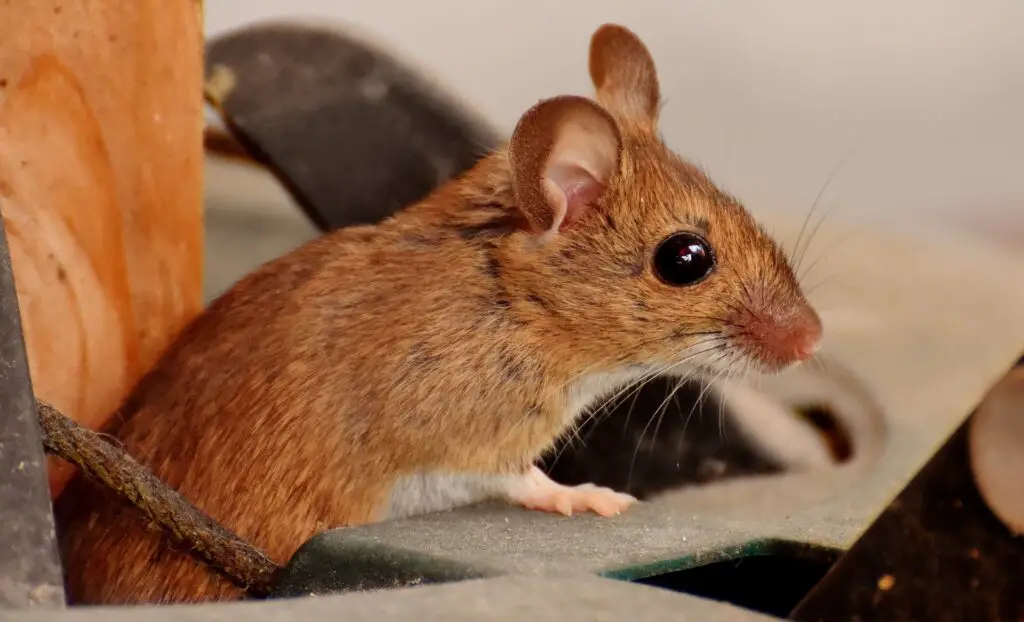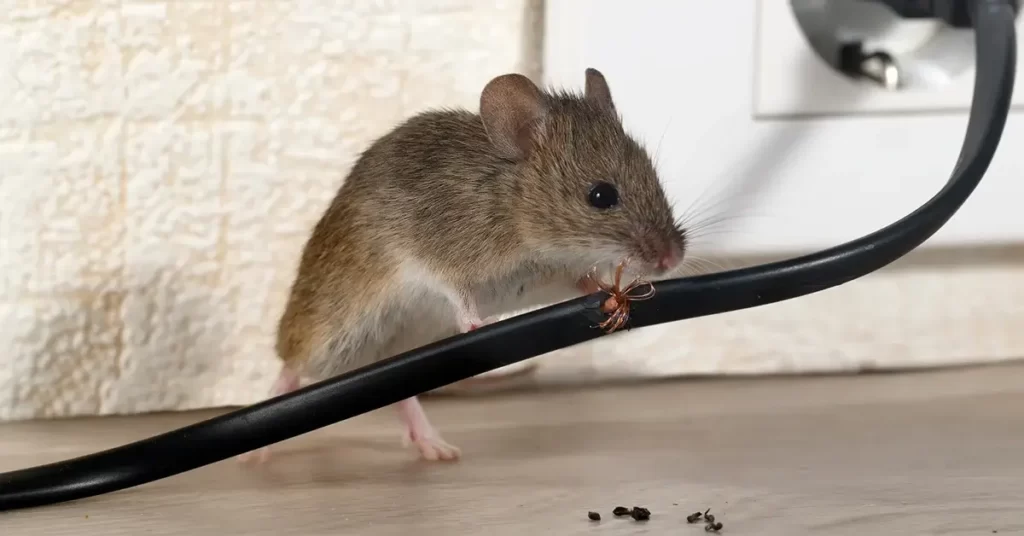Last Updated on August 16, 2023 By Emma W. Thomas
Mice enter homes in summer seeking food, water, and shelter. Warmer temperatures make outdoor conditions attractive, but they move indoors due to drought, seeking cooler environments. They can fit through tiny openings, with a ¼ inch being sufficient. Prevention and sealing entry points are key to control.
Why Do Mice Come In The House During Summer?
- Desire for Balanced Temperatures: During summer, the outdoor temperatures can become excessively high. Since mice are attracted to places with balanced temperatures, they are likely to make their way into houses where temperatures are regulated.
- Availability of Food: The presence of food elements in the house attracts mice. During the summer, food items, especially perishable ones, are often stored indoors. This builds a perfect attraction for mice to enter into houses.
- Drought Conditions: In certain regions, summers are associated with drought-like conditions. The scarcity of water drives mice indoors in search of hydrating substances, which are plenty in homes in form of water bowls, leaks, and condensation.
- Safe Breeding Ground: Mice tend to reproduce rapidly during summer due to favorable conditions. They seek safe and warm indoor spaces for breeding, leading to a higher likelihood of infestation.
- Availability of Shelter: Houses provide reliable shelter for mice, protecting them from predators and harsh outdoor weather conditions typical of the hot summer months.
- Abundance of Entry Points: The majority of homes have multiple entry points that mice can exploit during summer, such as open windows, doors, and cracks or holes in walls and foundations.
| Reasons Mice Come Inside | Explanation |
|---|---|
| Balanced Temperatures | Houses provide a cooler environment |
| Availability of Food | Indoor storage of food attracts mice |
| Drought Conditions | Scarcity of water drives mice indoors |
| Safe Breeding Ground | Houses provide safety for reproduction |
| Availability of Shelter | Protection from predators and harsh weather |
| Abundance of Entry Points | Open windows, doors, and other entry points |
Time Of The Year That Mice Come Inside Your House

Mice infestation in a home is not seasonal. Like other tiny creatures, mice need shelter from extreme weather all year round, including shelter from rain, cold and excess heat. But they may come in large numbers during summer to enjoy the cold basement or the shade from your home’s roof.
Rodents will find food and water supply from your home all the time. They will also get security from predators, and a safe place when giving birth.
During cold winter months, the horrible creatures may seek shelter in your house, which is warmer than outside. They will then move to the lower part of your home when summer falls and move back to your house’s living areas in warmer months.
How To Prevent Mice From Coming To Your Home
Preventing rodents from invading your home is more comfortable than getting rid of them when already inside. There are various things you can do as a homeowner to prevent mice infestation such as;
1. Pruning and trimming your lawn and shrubs since rodents like to have their nests outside
2. Keep away all plants and trees from the roof or from touching your house. Rodents may climb the limbs of trees that touch your roof to access your house
3. Store your food in airtight containers since rodents get attracted to food
4. Maintain and clean trash areas
5. Avoid stacking any materials by your garage and home
6. Clear all litter such as woodpiles and debris from your yard to prevent mice from nesting around your home
7. Maintain your drainage system and gutters and ensure there are no backups. Rodents can hide in your drainage system and cause havoc
8. Prune the back vegetation and set traps to catch mice before they enter your house. You should also seal any potential entry points around your home. You can call a professional to identify the areas that mice use and prevent their invasion
Why Should You Get Rid of Mice From Your Home?
Rodents are annoying creatures that will eat trash and food in your kitchen as well as carry and transmit various diseases to you. Mice are known to carry different diseases that they can spread through their feces and urine and also infect floors and surfaces. The various infections include;
1. Rat-bite fever
2. Salmonella
3. Bacterial food poisoning
4. Murine typhus
5. Hantavirus (it progresses into Hantavirus Pulmonary Syndrome – HPS) is a severe and sometimes deadly respiratory disease in humans.
How To Effectively Get Rid Of Mice From Your Home

Rodents are unwelcome to your home at any time of the year, and you should eliminate them at all costs. The following methods are effective;
- Seal all entry points
- Using the best mouse traps
- Place mouse traps properly
- Keep your house clean to avoid attracting mice
- Deal with mice both outside and inside the house
- Using mice bait stations
1. Sealing The Entry Points
Rodents access your home from cracks or crevices as well as doors that remain open for long. They may also get in through the places where utility pipes and vents are. Ensure that you seal the cracks and avoid using rubber, wood, plastic, or anything that mice can gnaw through.
You can also get weather stripping for window and door gaps.
2. Using The Best Mouse Traps
Mousetraps are effective in getting rid of mice infestation. You can use classic wooden snap traps for mice populations that are light to moderate. Using plenty and different types of traps such as multiple capture, bait, wooden, and glue traps will do the trick.
3. Using The Best Bait For Traps
Use the food that mice have been eating as bait, or approved favorites for mice such as peanut butter, oatmeal, chocolate, hazelnut spread, or dried fruit. Tie the bait onto the trigger using dental floss or a fishing line to ensure that mice don’t make off with the food.
Alternatively, secure the bait food with a hot glue gun and ensure to replace it with a fresh lure every two days. You can also use nesting materials such as feathers or cotton balls if food isn’t working.
4. Placing Mouse Traps Properly
Traps need to be placed perpendicular to the walls and ensure that the trigger section faces the baseboard. Since mice scurry along the walls, they will run directly to the bait instead of running over the trap and triggering it from the wrong direction.
Place the traps where there are signs of mice or wherever you see these creatures since they don’t travel more than ten to twenty feet from their nesting areas or food sources. Check for droppings or rubbings on walls and baseboards to know where they pass.
5. Proper Sanitation
Rodents do not need a lot of food per day for survival and will need just a few crumbs. Ensure that you wipe down your counters, vacuum the floors, and eliminate residue, crumbs, and food sources.
Store your food in airtight containers or glass jars, and also secure your garbage. Avoid plastic bags or containers since rodents have sharp incisors that enable them to chew almost anything.
How to find out where mice are getting into your house
1. Investigate Nocturnal Movement:
Mice are primarily nocturnal creatures, which means they are more prone to make their presence felt during the hours of darkness. Pay attention to noises in the walls or ceilings, or even the scuffling sounds on your floor.
2. Look Out for Mouse Droppings:
One key sign of a mouse infestation is their droppings, which are tiny, spindle-shaped pellets. The presence of these pellets especially in places like cupboards, under sinks, or behind furniture signifies that mice have been entering your house in these areas.
3. Identify Mouse Nests:
Mice typically construct their nests with shredded paper or other soft materials. Discovering a nest can provide a valuable clue about where mice are entering your home.
4. Search for Chewed Items:
Another sign of mouse activity is chewing damage. Mice have strong teeth and can chew through softer materials like wood, plastic, and cardboard. Look carefully at the corners and edges of these materials in your home for signs of gnawing.
5. Look for Footprints or Tail Marks:
A less common but still helpful method to locate possible mouse entry points is looking for footprints or tail marks in dusty areas. Mice are small and light, and won’t leave clear tracks unless the surface is sufficiently dusty or damp.
6. Recognize the Greasy Marks:
Mice often leave a greasy trail along walls and baseboards. These trails, known as “smear marks,” are created as the oils and dirt on the mouse’s fur rub off on surfaces they frequently travel along.
7. Identify The Scent:
Mice produce a distinct, musky odor. Though not always detectable by human noses, large infestations may give off this scent, directing homeowners toward their point of entry.
8. Spot Holes & Cracks:
Mice can squeeze through very small holes – some no larger than a dime. Check your structure carefully (inside and outside) for holes or cracks that may provide these creatures access to the inside of your home.
Final Word
Having rodents and other pests in your home is not only disgusting but unhygienic too. The creatures will easily transmit diseases to humans, and you need to eliminate them at all costs. Ensure that you seal all their entry points and put in place proper measures all year round.
References:
https://www.masseyservices.com/why-do-mice-come-into-my-home-in-the-summer/
https://bestpestcontrolboston.com/blog/why-do-mice-come-into-the-house-in-summer/
Emma is a graduate of Domestic Science or Family and Consumer Sciences (Home Economics) from the University of Wisconsin. She has 7 years of experience Working with the strategic section of BestBuy and now writing full-time for Homeeon.
From Managing the Home, Interiors, Cleaning, and Exteriors to Gardening and everything about Making A Home Liveable – is her passion and this Homeeon is the result of this.
Emma loves decorating her home with the best stuff found online. She cares about quality over anything and writes reviews about them here in Homeeon. Get in touch with her over Pinterest.
Keep reading her blogs.

